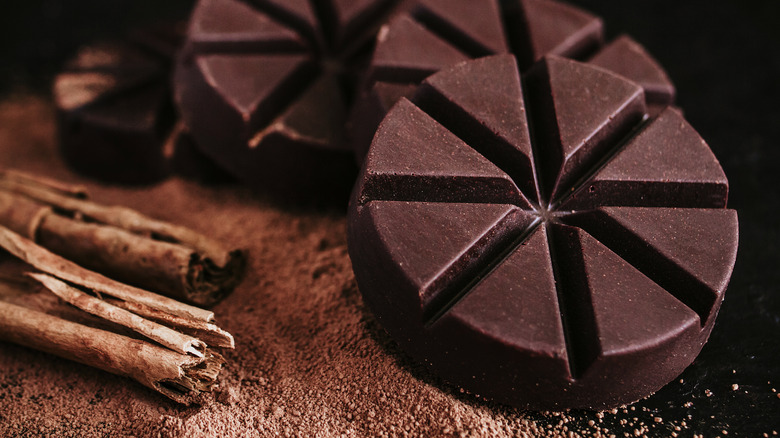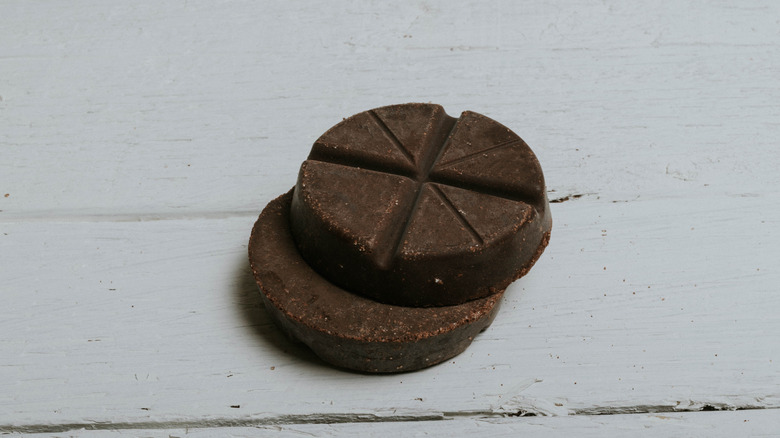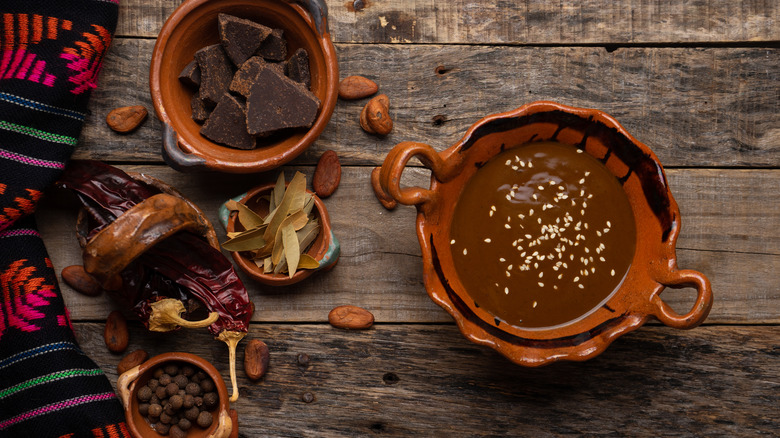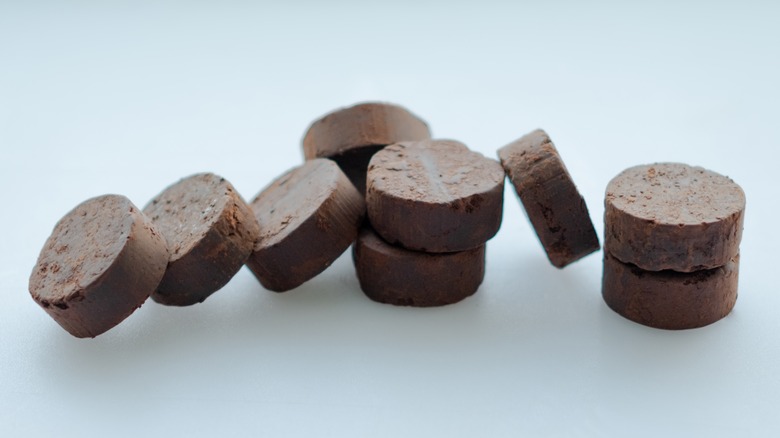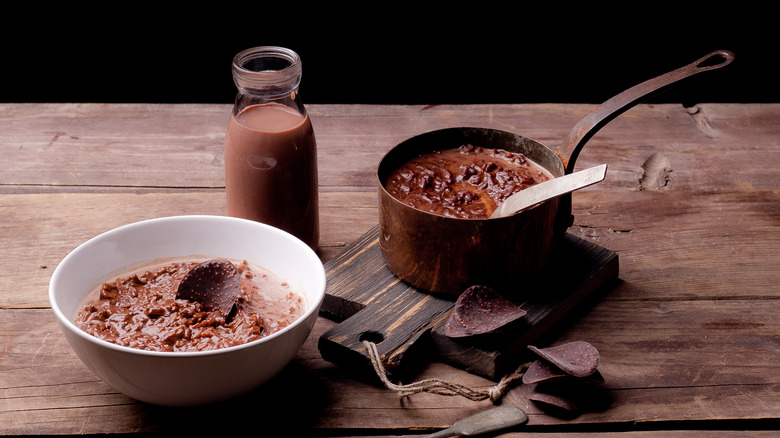The Difference Between Mexican Chocolate And Filipino Tablea
Mexican chocolate and Filipino tablea look so similar that you could be forgiven for thinking they are being made in the same region. But obviously, an ocean separates the places of origin of these two chocolate disks.
There is no chicken-and-egg discussion about which food culture came up with this style of processing cacao first. That honor goes to Mexico, which gets historical credit for introducing the world to the bean itself. While the Spanish colonized the new world, they stole cacao from the Aztecs. This led to the ingredient becoming the breakout culinary star of Europe in the 1500s, courtesy of Hernan Cortez who sent the beans back to Spain where cane sugar was added to chocolate drinks.
Once the Spanish got familiar with the fruit that would be chocolate, it took less than a century before cuttings were loaded onto ships that plied the galleon trade between Acapulco, Mexico, and Manila. While dates vary, there are historical accounts that say cacao was first brought to the Philippines by friars who wanted to grow their own beans, and that the first tree that was planted there was of the Criollo variety — which has never been cultivated for commercial use.
What is Mexican chocolate?
Mexico might have different brands offering up sweets and confections made with chocolate, but there is only one Mexican chocolate, which is the end product after roasting and blending cacao nibs with other ingredients like sugar and cinnamon. Other than cacao and sugar, the other add-ins are not set in stone, and Mexican chocolate can be made with different types of chiles, including pasilla and habanero, as well as with almonds and cardamom.
Mexican chocolate is most often made by hand and it doesn't go through processing the way European chocolate does, which results in a grainier texture. Making Mexican chocolate is a relatively simple process; once the cacao beans are roasted, they are then ground into a liquor before additives like sugar, spices, and nuts. Finally, they are shaped into logs or distinctive round discs, which can be eaten as is but are most often used in recipes.
Cooking with Mexican chocolate
One of the most common ways to take Mexican chocolate from disc to table is to use it for hot chocolate. To make an authentic cup of Mexican hot chocolate, a special whisk known as a molinillo is placed in a pot with hot water or hot milk; the handle is then rubbed between the palms of the cook's hand, twirling the whisk in the molinillo. That action is said to not just spin the liquid around, it also introduces air into the drink, creating foam.
But consuming Mexican chocolate as it is, and making hot chocolate with it aren't the only ways you can enjoy this specialty. Spiced Mexican chocolate is considered an essential ingredient for mole sauce, even though recipes sometimes call for dark chocolate as a substitute because Mexican chocolate can be difficult to find. You can also use Mexican chocolate as an optional ingredient for posole, the rich chocolatey stew featuring bits of meat and hominy, and it is a critical ingredient for champurrado, the rich hot chocolatey drink made with cornmeal.
What is Filipino tablea?
Filipino tablea and Mexican chocolate don't just look similar; the cocoa tablets are made in similar ways as well. To manufacture tablea, cocoa beans are first roasted and then ground into a thick chocolate mass. The chocolate can either be shaped into cocoa pucks without add-ins or with muscovado sugar, depending on the geographic region where it is made.
Other cacao products which are made in a similar way include tablea's Latin American cousins chocolate de mesa, which is found in Guatemala and the Dominican Republic, and the spiced chokola peyi from Haiti.
Though similar, Filipino tablea and Mexican chocolate are distinct; while Mexican chocolate is either flavored or spiced, no other ingredients beyond sugar are added to Filipino tablea. Some artisanal cocoa manufacturers don't even ferment the cacao mass first, which means the tablea you end up with could be milder in chocolate flavor than you'd typically expect from pure cacao.
Cooking with Filipino Tablea
Filipino tablea can be used in a variety of recipes. To turn Filipino tablea into tsokolate or hot chocolate, you'll want to grab a whisk that is reminiscent of the Mexican molinillo, known as the batirol; it is even used in the same way. The handle of the batirol is secured between the palms of the cook's hand to make the liquid frothy, but other than aerating the drink, the batirol is also used to make sure that no bits of tablea stick to the bottom of the cooking pot. It can take up to half an hour to make sure tablea is completely dissolved. Once the tablea has been liquified, it can be used as an ingredient in popular Filipino desserts from western-style tortes, cupcakes, and brownies, to Filipino rice rolls known as suman or budbod, and the chocolate sticky rice porridge champorado.
But while Mexican chocolate and tablea might look similar, because their ingredients are slightly different, we wouldn't recommend using tablea as a substitute for Mexican chocolate or vice versa. Tablea lacks the spices and flavors — like chiles or cinnamon — that are added to Mexican chocolate and are expected to add flavor to these dishes. In the reverse, Mexican chocolate might add these flavors to Filipino cooking where they wouldn't be expected. Instead, it's probably best to enjoy these similar but different chocolates exactly as they are.
